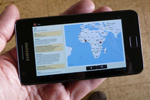|
For anyone responsible for keeping the public safe, the explosive growth of social networking services and new communications technologies bring new opportunities to enhance that safety. They are also simultaneously challenging traditional work methods and ways of interacting with the communities that they serve – and those challenges are fast accelerating in often unexpected and unpredictable ways. Just how fast that traditional landscape is changing is reflected in recent figures from world markets. Over 5½ billion people on the planet now have a mobile phone. Those who own a smartphone able to run advanced messaging, video, location and other applications now make up around 20 percent of that total – a figure that’s rapidly growing and is expected to reach around 70 percent in developed markets such as the US later next year. On top of this must be added the continued growth in broadband connectivity and the introduction into the home of new IP-enabled devices such as connected TVs and games consoles. While the mobile phone by itself has certainly helped increase the public’s perception of its own safety – and helped the emergency services to track and respond to events far faster than was possible in the old days of wireline services – interaction was initially limited to basic voice services. These days, with the arrival of smartphones, increasingly ubiquitous 3G, 4G and Wi-Fi connectivity and the global spread of entirely new applications such as Facebook and Twitter – which network humans themselves, not just their devices – the whole public safety environment is on the brink of a major shift. That shift is being driven by the inherently subversive nature of the communications technologies that are now in place around the world. They are eroding traditional boundaries between applications, processes, people, organizations and countries. Historic hierarchies and closed domains in governments and business are being affected, for good or ill. Once stable, top-down linear models of communications and control are being challenged by bottom-up activity, driven by once isolated individuals now able to react in collective, coherent ways that bypass the status quo, using so-called Web 2.0 models to drive new models of community interaction on both a global and local scale. Critical massWhile some of these initiatives – especially where major disasters or critical events are involved – involve the use of specially developed platforms and applications, many public safety organizations and the communities that they serve are already using standard tools such as Facebook and Twitter. While vulnerable to the shifting winds of consumer fashion, these specific services have – for the time being at least – reached a critical mass that makes them vital building blocks for almost any strategic planner involved in public safety. Though its subscription take-up now is slowing, Facebook alone has nearly one billion users worldwide – half of whom access it through a mobile device. Twitter, the social networking and micro-blogging service, currently has half a billion registered users and has already proved invaluable in a number of major disasters, from forest fires in California to the Szechuan earthquake in 2008. But how best should public safety operators react to these developments? While on one hand there are technical issues to be resolved in integrating these new technologies with existing in-bound and out-bound communications and control systems, there is a far more extensive and complex set of organizational and policy issues to be dealt with, where wider incident management, decision making and public confidence are concerned. In an effectively boundary-less and highly dynamic world, the old saying that “a lie is halfway around the world before truth gets its boots on” is especially true. Both information and disinformation will be freely circulating out there, particularly if there is a political angle to a major incident or criminals are themselves using these technologies to co-ordinate activities, as happened during riots in the UK in August last year. Tracking eventsIn terms of using these new services to firstly monitor what’s happening out there and to anticipate and track events as they happen, many public safety organizations are already adding social media to their monitoring list, alongside online and TV news services. At the recent TETRA World Congress in Dubai, the control room systems vendor APD Communications launched a new version of its Cortex ICCS system which incorporates feeds from social media into the inbound communications matrix to support decision-makers. Simon Read, head of product management at APD, takes up the story: “There are essentially two angles here – how public safety organizations can use social media to spot, manage and monitor emerging issues and incidents, and how they can also use social media and other tools to better communicate with their communities.
|

 Few, at first, recognized any wider value in social media. But now they have grown into a source of real-time information for public safety forces. Alun Lewis investigates
Few, at first, recognized any wider value in social media. But now they have grown into a source of real-time information for public safety forces. Alun Lewis investigates